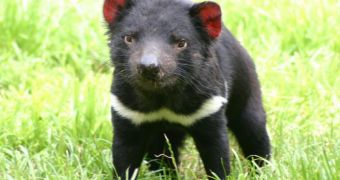Fatal facial cancer tumors have been ravaging the Tasmanian devil populations ever since the mid 1990s, killing up to one third of the total number of the world's largest surviving carnivorous marsupials in the last decade or so. The fatal devil facial tumour disease (which in Tasmanian devils is probably spread during fights), along with the venereal sarcoma (which is passed among dogs during mating), are the only known tumor diseases that are transferred through direct contact.
Now, a new study suggests that the populations that have been affected by the disease the most are trying to fight it off by breeding much earlier in life. Ecologist Menna Jones of the University of Tasmania has been monitoring the ages at which females of five populations of Tasmanian devils gave birth for the first time before and after the onset of the disease. The results showed that while Tasmanian devils usually breed in their second, third or fourth year of their lives, in populations in which the disease was established up to 80 percent of the females bred after their first year of life.
Before the populations were affected by the disease, when life expectancy was much higher, less than 10 percent of all females bred when they were only one year old. "We found a sixteen-fold increase in precocious breeding. They are fitting in an extra litter when they are teenagers," she said. Exactly what is triggering this behavior is yet unknown, albeit it could be the result of the lack of competition as the population numbers drop.
The Tasmanian devil (Sarcophilus harrisii) is part of a species known as dasyurid mammals, breeding at an early age and dying only after roughly six years of life. This typical live-fast-and-die-young strategy used by the Tasmanian devils could also suggest that they are evolving fast to an even earlier breeding habit.
"Rapid evolution tends to occur when you have high mortality. These animals are already predisposed to breeding early, and the disease is taking out all the individuals over one year in some areas - it's a very strong selective pressure," says Mathew Crowther of the University of Sydney.
In the last couple of years, more than half of the Tasmanian devil populations have contracted facial cancer, a disease that could just as well push the animal into extinction within the next three decades.
"There's a little bit of hope that precocious breeding can keep the devil population ticking over. But with such heavy mortality, and all reproduction [now] having to occur in one season, they are very vulnerable," Crowther added.

 14 DAY TRIAL //
14 DAY TRIAL //